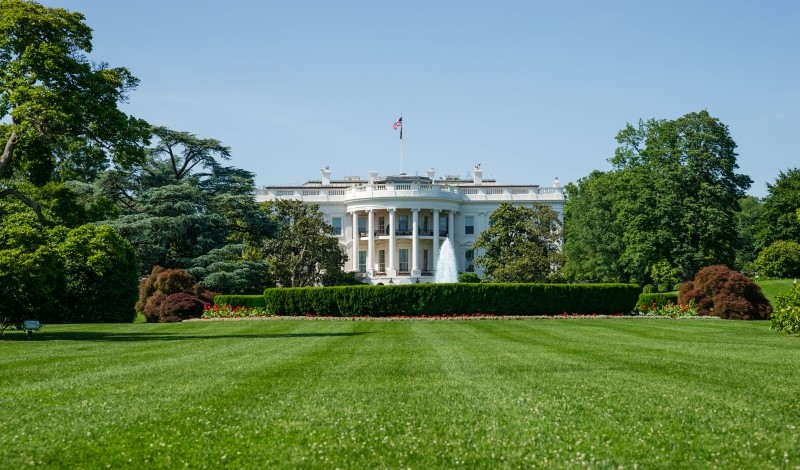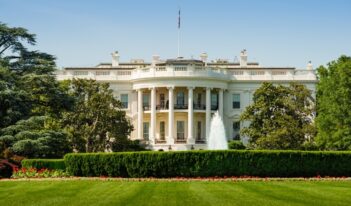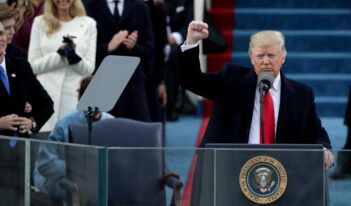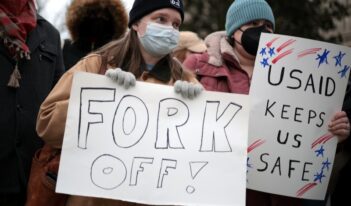
In Trump v. United States, the Supreme Court has expanded executive power and elevated the President above the law.
The U.S. Supreme Court’s decision on former President Donald Trump’s claim of immunity from criminal prosecution—Trump v. United States—was its last full opinion of the October 2023 Term. For anyone hoping the Court would honor the rule of law in this gravest of disputes, the majority’s performance was frightening and demoralizing. With its eyes firmly averted from “present exigencies,” the Court wrote an opinion that paves the way to a yet more unaccountable presidency.
The dangers that the Trump decision poses are not so much in the shortest term—the timing of the Court’s consideration already assured that former President Trump’s D.C. trial would not occur before the presidential election. Indeed, it is even conceivable that, if Trump loses the November election, this opinion will not shield him from prosecution for all the crimes of which he has been accused. What is frightening about the opinion are its implications for the presidency going forward. If one is looking for the opinion’s analytic antecedent, the place to look is not in U.S. Reports, but in the 19-page letter then-private lawyer Bill Barr wrote to Department of Justice officials in June 2018, arguing that President Trump could not be prosecuted for obstruction of justice. Barr argued that, because of the President’s supposedly illimitable power over criminal prosecution, even self-interested interference with an investigation of his friends and family could not legally be deemed “corruption.”
The Court’s Trump v. United States holding is that, for purposes of determining the scope of a president’s immunity from criminal prosecution, it must first be determined into which of three categories the conduct in question falls. To begin, as former President Trump conceded, and the majority agrees, no immunity exists when the President engages in “unofficial acts,” a category the Court does not define. The Court is clear, however, that an “official act” does not become “unofficial” because of its motive. Thus, a presidential tariff imposed to help a son-in-law’s business would be no less official because of its illicit impetus. Echoing the uncited Barr analysis, the Court holds: “In dividing official from unofficial conduct, courts may not inquire into the President’s motives.”
At the other end of the majority’s immunity spectrum stand presidential actions within areas of “exclusive constitutional authority.” In that zone, immunity is absolute: “An act of Congress—either a specific one targeted at the President or a generally applicable one—may not criminalize the President’s actions.” As for the judicial branch: “Neither may the courts adjudicate a criminal prosecution that examines such presidential actions.”
Remarkably, the Court cites as one such “conclusive and preclusive” Article II authority “the President’s power to remove—and thus supervise—those who wield executive power on his behalf.” The majority thus seems, in dicta, to have obliterated a limitation to its ruling in Seila Law v. Consumer Financial Protection Bureau—namely, that, following Humphrey’s Executor v. United States, Congress may protect the tenure of members of multi-member independent commissions from at-will presidential removal. As it happens, the constitutionality of independent agencies was neither briefed nor at issue in the Trump prosecution. But when writing “for the ages,” as Justice Neil Gorsuch foreshadowed in oral argument, perhaps judicial restraint does not come easily.
Between the realm of unofficial activity and the zone of “exclusive presidential authority” lies a third category: Presidents execute other duties “within the outer perimeter of…official responsibility.” For actions taken “not manifestly or palpably” in excess of this authority, Presidents enjoy “at least a presumptive immunity from criminal prosecution.” (The italics are in the Court’s opinion.) How strong is that presumption? The Court’s majority hedges on whether the government can ever overcome the presumption. At the very least, the government cannot do so “unless the government can show that applying a criminal prohibition to that act would pose no dangers of intrusion on the authority and functions of the executive branch.” (These italics are mine.) The majority never addresses whether any truly zero-danger scenarios could ever exist.
Because the majority sees the factual record as yet insufficiently developed to apply its framework fully, it offers only “guidance” to the lower courts in former President Trump’s case. That “guidance,” however, includes a conclusive determination that allegations in the indictment about Trump’s communications with the Justice Department “plainly implicate Trump’s ‘conclusive and preclusive’ authority.” Thus, such interactions may not be the basis for criminal prosecution.
The exclusive powers that the Court’s immunity protects include the “investigation and prosecution of crimes”—with the obligatory ceremonial citation to Justice Antonin Scalia’s dissent in Morrison v. Olson—and the power to manage the Attorney General, over whom the President has a plenary power of removal. Moreover, because conversations with the Justice Department may not be prosecuted as acts of conspiracy or obstruction, they also may not be introduced to show former President Trump’s knowledge that his claims of election fraud were false. According to the majority, any “use of evidence” about a President’s official conduct “even when an indictment alleges only unofficial conduct, would…heighten the prospect that the President’s official decision making will be distorted.” On this point, even Justice Amy Coney Barrett, in her partial concurrence, jumps ship.
Justice Barrett also states in her partial concurrence that President Trump’s “alleged attempt to organize alternative slates of electors” clearly amounts to private conduct and is “therefore not entitled to protection.” In light of the majority’s protectiveness of former President Trump with regard to his Justice Department interactions, one would have expected the justices to embrace Barrett’s seemingly incontestable conclusion, at least in the interest of a balanced assessment. Instead, the majority holds out rather fanciful reasons why the lower court, on remand, will need to undertake “a close analysis” to determine if President Trump’s pressuring his Vice President to act unlawfully or his attempted interference with state electoral processes was “official.” Likewise, the lower courts will have to examine all of President Trump’s January 6 tweets and other communications, plus his speech on that same morning, to determine if he was speaking as a candidate and party leader or, rather, in his official capacity. Such a factual assessment must reflect an “objective analysis of ‘content, form, and context,’” except that the examination of context presumably cannot include any mention of President Trump’s earlier efforts to leverage the Justice Department powers to perpetuate a lie about the outcome of the 2020 election.
What is demoralizing about the opinion—aside from its bottom-line threat to the rule of law—is its shallow, tendentious reasoning. The principal dissent by Justice Sonia Sotomayor, joined by Justices Elena Kagan and Ketanji Brown Jackson, takes on every element of the majority’s reasoning, asserting that under its theory of immunity, a President who “orders the Navy’s Seal Team 6 to assassinate a political rival” could not be prosecuted. Not for the first time, Chief Justice John Roberts is pointedly dismissive of a Justice Sotomayor opinion, in this case for “fear mongering on the basis of extreme hypotheticals.” Yet it is difficult to see why Justice Sotomayor’s reading is unjustified. The President’s supervisory authority over the military, after all, is no less “conclusive and preclusive” than is the presidential supervision of the Justice Department. Of course, Congress, at least in principle, could impeach and remove a murderous President. And Article I of the U.S. Constitution states explicitly that any official who is convicted following impeachment “shall nevertheless be liable and subject to indictment, trial, judgment and punishment, according to law.” The majority does not discuss how to square this language with its theory of immunity. Indeed, it purports to reject Trump’s argument that impeachment and removal are prerequisite to criminal liability.
Nonetheless, because the Court orders a remand, it remains possible—if former President Trump loses the 2024 election—that the new immunity framework, applied to his past acts, will not ultimately shield him from criminal liability in connection with January 6. There are clearly at least four votes already, including Justice Barrett’s, for characterizing much of Trump’s conduct cited in the indictment as private. If he is not in office and thus not empowered to stop the prosecution, the majority’s analysis, if applied sensibly, will prove an imperfect shield. What is frightening, however, is that the Court has effectively carved out what Justice Sotomayor appropriately finds to be a capacious “law-free zone” for future presidents. The majority’s analysis, in the hands of as rule-oblivious a figure as former President Trump, lays out a legal template for how to justify breaking the law with impunity. It is notable that, armed with this opinion, President Richard Nixon would certainly have had plausible arguments in 1974 that many, if not all of the acts mentioned in the articles of impeachment adopted against him by the House of Representatives Committee on the Judiciary could not constitutionally have formed the basis for any criminal prosecution. He might still have resigned, but the pardon granted to him by President Gerald Ford would have been unnecessary.
It is the imbalance in the Trump Court’s opinion, as well as its obliviousness to history, which makes the decision so discouraging, as well as dangerous. The Court makes no mention of the Nixon pardon. Nor does it cite earlier executive branch legal opinions positing the susceptibility of a former President to criminal prosecution for acts undertaken while in office. It ignores the position taken by Senators at Trump’s second impeachment trial who explicitly accepted his lawyers’ argument that accountability for his malfeasance in the events leading up to January 6 lay with the criminal justice system. An amicus brief that Justice Sotomayor cites favorably (which, in full disclosure, I joined), points out that although some early state constitutions spell out immunities for governors, the Framers adopted no such text.
Instead, the majority’s analysis is driven entirely by a historically dubious interpretation of the constitutional presidency. Under this view, the President is constitutionally the “only person who alone composes a branch of government”—a depiction that, at the very least, makes the Constitution’s reference to the “executive departments” puzzling. Within the President’s zone of constitutional authority, there can be no “intrusion” by the other branches. Neither Congress’s power to enact laws about every “department,” or “branch” of government, nor the premise underlying an independent judiciary—namely, that law will apply equally to all—is ever accounted for. Instead, the President must have maximum leeway to undertake “bold and unhesitating,” “energetic and vigorous” action without concern for obedience to law. In response to Justice Sotomayor’s inferences from the Constitution’s silence on executive immunity, the majority responds: “True, there is no ‘presidential immunity clause’ in the Constitution. But there is no ‘separation of powers clause’ either.” What this riposte ignores is there is also in the Constitution no “checks and balances clause” and no “rule of law” clause. Yet it is beyond doubt that the Constitution envisions both, and each is more firmly rooted in the Constitution’s text, history, and tradition than is a formal, wooden conception of the separation of powers.
In separation-of-powers clashes prior to the Roberts Court, the majority’s predecessors preferred to rely on balancing rather than placing the President inside an impervious bubble. When a unanimous Court rejected President Nixon’s claim of absolute immunity in connection with the Watergate tapes, it recognized that there were competing interests to be weighed:
When the privilege depends solely on the broad, undifferentiated claim of public interest in the confidentiality of such conversations, a confrontation with other values arises…In designing the structure of our government and dividing and allocating the sovereign power among three co-equal branches, the Framers of the Constitution sought to provide a comprehensive system, but the separate powers were not intended to operate with absolute independence.
In upholding the Presidential Recordings and Materials Preservation Act—Congress’s initial scheme for regulating the curation of the Watergate tapes—the Court held that, whenever courts confront a statute touching on the executive branch of government, it must determine whether the act in question “disrupts the proper balance between the coordinate branches”:
The proper inquiry focuses on the extent to which it prevents the executive branch from accomplishing its constitutionally assigned functions. Only where the potential for disruption is present must we then determine whether that impact is justified by an overriding need to promote objectives within the constitutional authority of Congress.
In former President Trump’s case, such balancing would seem relevant—and, indeed, conclusive—in finding that a President might be criminally indicted for conspiring to subvert Congress’s proper performance of its constitutional role in determining who is the President-elect. The Court never even discusses the proposition.
In short, Trump v. United States places no weight on the constitutional authorities of Congress or the judiciary—much less on the public interest in promoting the rule of law through criminal prosecution. Instead, the majority explicitly states that it is less worried about presidential criminality than “the more likely prospect of an executive branch that cannibalizes itself, with each successive President free to prosecute his predecessors, yet unable to boldly and fearlessly carry out his duties for fear that he may be next.” If such fecklessness is “more likely,” it is chiefly because of a 2024 presidential candidate who, in a prior campaign, called for the imprisonment of his opponent, who, while President, called for the prosecution of members of Congress investigating him, and who, in this campaign season, has raised the prospect of targeting his adversaries if reelected—even by subjecting them to military tribunals. After Trump v. United States, a reelected President Trump could more easily pursue any of these actions with impunity.
This essay is part of a series, titled The Supreme Court’s 2023-2024 Regulatory Term.




